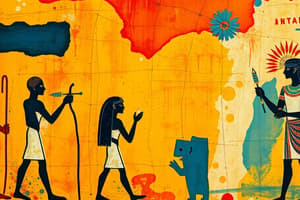Podcast
Questions and Answers
What do the oldest known images painted or drawn on rocks and cave walls reflect?
What do the oldest known images painted or drawn on rocks and cave walls reflect?
- The development of writing
- Human's latest forms of communication
- A complex language system
- One of humans' earliest forms of communication (correct)
Where was the oldest known prehistoric art created?
Where was the oldest known prehistoric art created?
- A cave in Europe
- A mountain in Asia
- A riverbank in Australia
- A rock face in South Africa (correct)
What is significant about caves in terms of preserving prehistoric art?
What is significant about caves in terms of preserving prehistoric art?
- They are easily accessible
- They provide protection and preservation of the art on their walls (correct)
- They are only found in Europe
- They have a dry climate
Who built the first camera obscura or pinhole camera?
Who built the first camera obscura or pinhole camera?
What did Johann Schulze discover in 1727?
What did Johann Schulze discover in 1727?
Who successfully made the first photograph in 1826?
Who successfully made the first photograph in 1826?
Who invented the calotype in 1839?
Who invented the calotype in 1839?
What was the first commercially successful photographic process?
What was the first commercially successful photographic process?
When did the first people write about the basic idea of a pinhole camera?
When did the first people write about the basic idea of a pinhole camera?
What did Girolamo Cardano suggest adding to the camera obscura?
What did Girolamo Cardano suggest adding to the camera obscura?
Who coated a glass plate with albumen in 1847?
Who coated a glass plate with albumen in 1847?
Who introduced the wet collodion process in 1851?
Who introduced the wet collodion process in 1851?
What was discovered by Sir George G. Stokes in 1852?
What was discovered by Sir George G. Stokes in 1852?
Who invented the gelatin dry plate silver bromide process in 1871?
Who invented the gelatin dry plate silver bromide process in 1871?
Who patented the autochrome color photography plates in 1904?
Who patented the autochrome color photography plates in 1904?
In what year was the Leica camera, a miniature 35 mm camera, introduced in Germany?
In what year was the Leica camera, a miniature 35 mm camera, introduced in Germany?
Flashcards are hidden until you start studying
Study Notes
Oldest Known Art
- The oldest known art in the world reflects one of humans' earliest forms of communication, with possible connections to language development.
- The earliest known images often appear abstract and may have been symbolic, while later ones depicted animals, people, and hybrid figures that perhaps carried some kind of spiritual significance.
- The oldest known prehistoric art was drawn on a rock face in South Africa 73,000 years ago, predating any known cave art.
Development of Photography
Pre-Photographic History
- Hassan Ibn Al-Haytham built the first camera obscura or pinhole camera, significant in the history of optics, photography, and art.
- Girolamo Cardano (1550) suggested adding a convex lens on both sides to the opening of the camera obscura to enhance image brightness and sharpness.
- Giovanni Battista Della Porta (1558) added lenses and curved mirrors to produce an upright image.
- Daniele Barbaro (1568) invented a diaphragm.
Evolution of Photography
- 5th century (China): The first people to write about the basic idea of pinhole camera.
- 1727: Johann Schulze discovered that sunlight would blacken chalk that had been treated with a solution of silver nitrate.
- 1800: William Herschel discovered infrared.
Photographic Techniques and Processes
- 1826: Joseph Niepce successfully made the first photograph, a reproduction of a 1710-century Dutch engraving showing a man leading a horse.
- 1839: William Henry Fox Talbot invented the calotype, a silver chloride-coated light-sensitive paper that was fixed with a strong salt solution.
- 1839: Louis Jacques Daguerre invented the Daguerreotype Camera, the first commercially successful photographic process.
- 1847: Abel Niepce de Saint-Victor coated a glass plate with albumen (the white of an egg) which held the chemical fast.
- 1851: Frederick Scott Archer introduced the wet collodion process to hold the silver compounds on glass, resulting in a much faster reaction of light.
- 1852: Sir George G. Stokes discovered ultraviolet (UV) fluorescence.
- 1857: D.A. Woodward first constructed an enlarger.
- 1858: French photographer and balloonist Gaspar Felix Tournachon took the first known aerial photograph of the French Village of Petit-Becetre.
- 1861: Maxwell and Sutton were able to successfully make color separation negatives.
- 1871: Richard Leach Maddox invented the gelatin dry plate silver bromide process.
- 1873: Dr. Hermann Wilhelm Vogel discovered dye-sensitizing technology that extended the color sensitivity of black-and-white films into the red region of the visible light spectrum.
- 1877: William Abney gave practical directions for manufacturing emulsions and invented copper bromide-silver nitrate intensification.
- 1880: George Eastman set up his Eastman Dry Plate Company in New York and the first half-tone photograph appeared in a daily newspaper.
20th Century
- 1900s: Experiments were made with new printing techniques to make photographs look like paintings.
- 1904: The Lumiere brothers patented the autochrome color photography plates.
- 1906: A film sensitive to all colors called "panchromatic film" was produced.
- 1907: The first color plates were put into production by Auguste and Louis-Lumiere.
- 1907: In Colorado, USA, intoxicated persons were being photographed by the police department, while the use of photographic speed recorders to detect speeders was approved in Massachusetts.
- 1924: The Leica camera, a miniature 35 mm camera, was introduced in Germany.
Studying That Suits You
Use AI to generate personalized quizzes and flashcards to suit your learning preferences.




